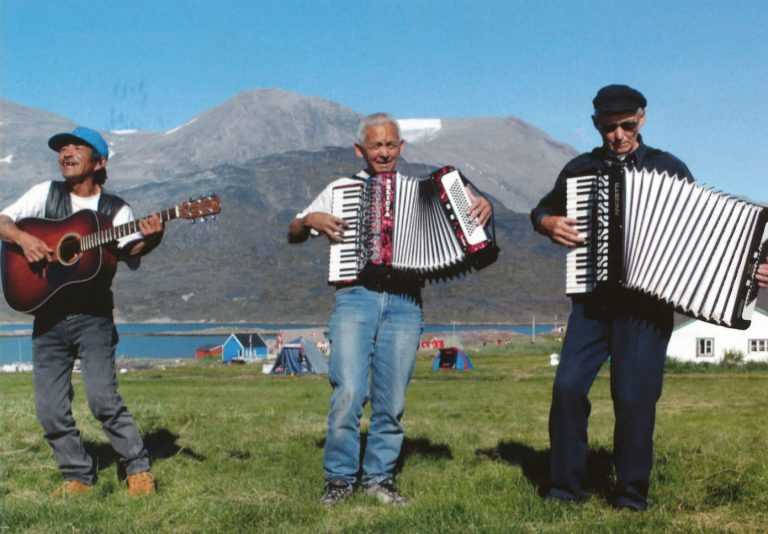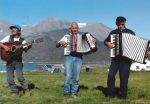Greenland is the world’s largest island with a total area of 2,166,086 square kilometers; it is also one of the world’s least densely populated. It also offers exotic Northern Lights fluorescing over the land, its people, indigenous culture and music. The indigenous culture – built on the Inuit hunting traditions – stretches along the entire length of the Arctic coastline towards the west, then over the North American continent and Siberia.
Perhaps, because we are so few inhabitants in Greenland (only 56,000, of which approx. 50,000 have Greenlandic as their mother tongue), it is natural that a powerful, charismatic singing voice – such as that of Rasmus Lyberth’s – is required to be heard, also on the Nordic music scene using the Greenlandic language. Greenland’s entire population can be equated with that of a provincial city in other Nordic countries, which makes the fact even more impressive that more and more Greenlandic singers and musicians have begun to make their mark in the music world outside of the Nordic countries.
The singer Julie Berthelsen experienced her big breakthrough in Denmark after a series of television competitions: she was named Popstar 2002. Since then she has done well and has won a number of Danish music awards, amongst which include Singer of the Year 2003 received during a competition with many Danish singers, both male and female. Julie Berthelsen, one of today’s best known and popular singers in the Danish Kingdom and Greenland, sings in English when she performs outside of Greenland – as opposed to Rasmus Lyberth. Her music is more of a soft, popular style.
The singer Angu Motzfeldt is also one of the Greenlandic singers who is on his way up in the Danish and Nordic music scene using texts in English in his own compositions. Another up-coming Greenlandic singer and musician is Simon Lynge who – also using English – has chosen USA and England as the platform for launching his career.
Noteworthy for this new generation of Greenlandic singers and musicians is their use of English and international, musical forms of expression and styles as a tool to make a name for themselves and thus rise towards the tip of the musical iceberg where the competition is fierce. Whether this is an expression of globalization, or perhaps an acknowledgement of a necessary requirement to have a hope of having a career beyond one’s own borders, is not clear, but is a practice adopted years ago by our neighbors to the east, namely the Icelanders. And yet? There is still the question of the way in which a music style and expression are actually used despite the language chosen.
Hip hop and rap, as well as break dance, the new generation’s global music are also heard in Greenland in the music of such groups as Nuuk Posse, Lucas, Prussic, Breakers and Freestyle Contest. Several have English names, but use the Greenlandic language. Frequently, these groups participate in international events and are enthusiastically received by the public, revealing that the new generation understand one another musically, regardless of language.
The drum song and drum dance with their many variations were an indigenous Inuit form of musical expression which live on in East and North Greenland, Arctic Canada, Alaska and Chukotka. The collective total of the Inuit throughout this enormous land area is surprisingly small, at about 100,000 compared to the smaller island of Iceland to the east where there are just under 300,000 inhabitants.
The challenge for Greenland and the Inuit folk is the preservation and further development of the indigenous culture and music despite the massive influence of the globalized continental mass culture, delivered via television and the Internet.
The Greenlandic singer, Karina Moller along with the group with which she performs – Pamyua from Alaska – have found the “feels right” concept for developing this balance. In addition to the indigenous Inuit musical form, the group has developed a way to incorporate other ethnic and afro forms of expression, or in other words, the use of world music. Pamyua was awarded the sought after distinction in 2003 in the United States of America of being named the best representation of “native American music” during the 45th Annual Grammy Awards in New York. The group enjoys a fantastic career both in the States, in Europe and in other parts of the world.
It is perhaps Pamyua’s concept that should be used more on the international music scene to brighten the future of Greenlandic music – assuming that the new generation chooses music as a profession – by employing a multi cultural musical expression based on world music with roots in one’s own indigenous culture. – A tendency best expressed in Etoiles Plaires and Cross-Roads productions.
The first group to appear on the music scene early in 1970 was SUME – who are still giving concerts as pioneers for modern Greenlandic music. Below this tip of the iceberg are found many individuals and groups engaged in music. Names such as Ole Kristiansen, Chilly Friday, Naneruaq, Peter Enoksen, Inneru- ulat, Enok Poulsen, Disco Bay Blues, Pele Moller Band, DDR, Igalikormiut, Tupaarnaq and many others have contributed to the diversity of Greenlandic music.
Looking at the historic dimension, just 50 years ago Greenland was a colony of Denmark and a country isolated from the rest of the world. Only after the establishment of Home Rule 25 years ago has the country developed its own internal educational institutions, including structured music education. Just 10 years ago music education was first offered at a music school in the capital city of Nuuk. It is therefore even more satisfying to see and hear the younger generation working with music, focused and engaged in both classical and pop styles. There is no doubt that there is a large pool of talent from whom the public will hear much more in the future.













